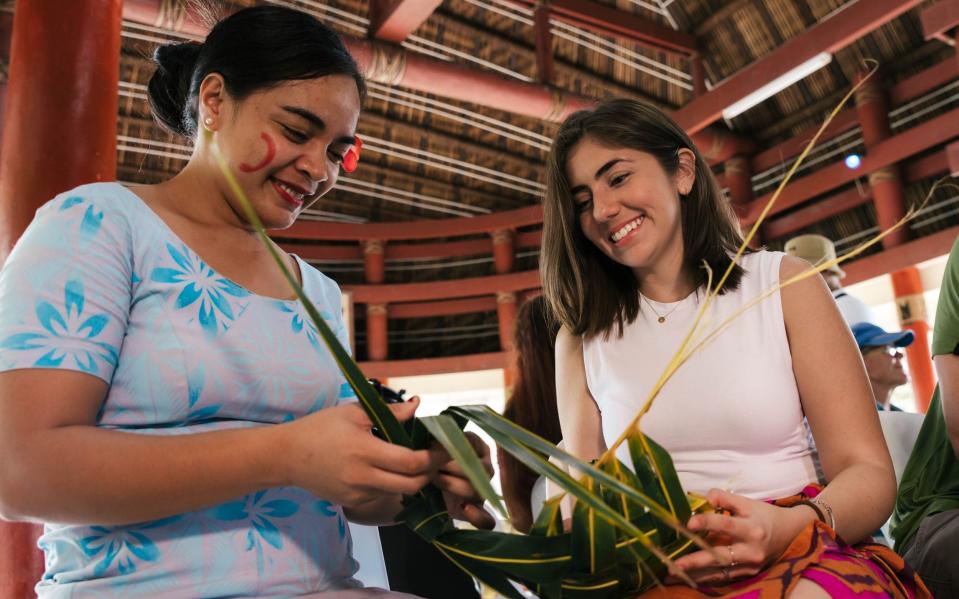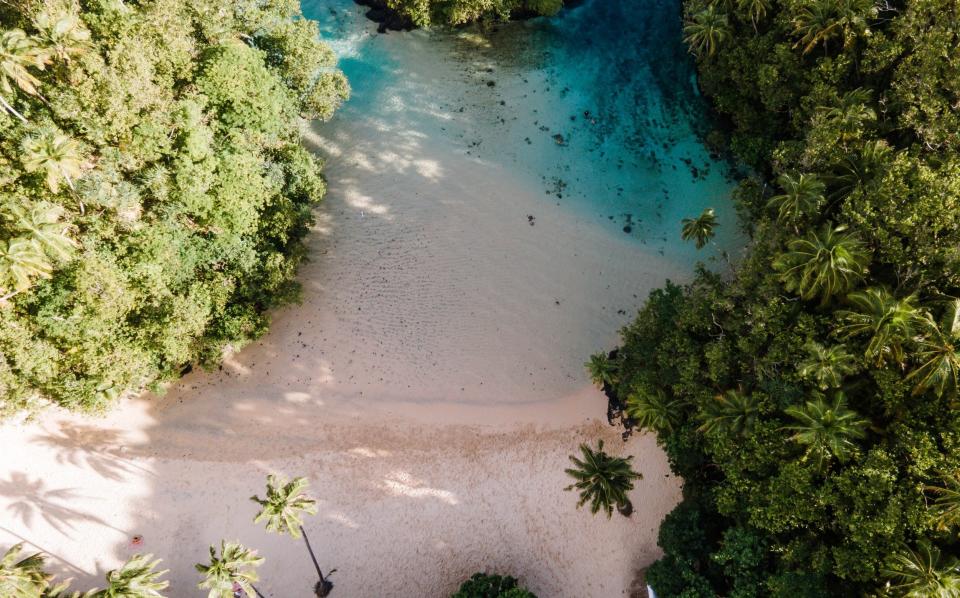It was like a simple sketch Treasure Island It first took shape in the mind of Robert Louis Stevenson. In the summer of 1881, he painted an imaginary, romantic island in Scotland. This would be the setting for his children’s tale of pirates, rebellions and buried treasure. But seven years later, he discovered his precious island, which he would fall in love with and would make his home until his death in 1894.
Samoa’s main island is Upolu; There are nine more, all but one small and a few uninhabited. Stevenson built his colonial-style villa, Vailima, at Upolu, complete with two Scottish baronial fireplaces – but for obvious reasons these were never lit. In this tropical climate, located just below the Equator in the heart of the South Pacific, volcanic peaks are covered with extremely abundant vegetation. (Then imagine Stevenson and his family buttoning up their Victorian clothes.)

It is a country full of natural wonders, as it was then. Rainforest descends to a coastline surrounded by pearly white beaches and turquoise waters, where turtles swim alongside you just off the beach. In the mountains, waterfalls create natural pools for bathing. You can swim in the deep blue waters of the To-Sua Ocean Pit, which is reached by a 30-meter ladder, and from there you can pass through the caves and reach the sea.
On the second island of Savai’i there is a great roar as blowholes force thousands of liters of seawater spectacularly into the sky. (Local children occasionally put coconuts on top for extra explosive effect.) Nearby lava fields are the dark remains of what followed the eruption of Mount Matavanu in 1905. Molten lava engulfed five villages as it moved towards the coast; A roofless church is still standing, although lava has overflowed from inside and around it. Surprisingly, everyone survived; Locals fled to the sea using coconuts as makeshift life jackets.
Samoans seem to take most things in their stride. Life is quiet, there is little crime, the roads are empty, everyone goes to church (“Have a blessed day” is a common form of farewell and contains absolutely no Handmaid implications). It is the center of village life and where everything is decided, from permission to build houses to punishment for misdemeanors. Meetings are held in fales, which stand on stilts with poles supporting their thatched roofs; There is no wall. Until about a decade ago all Samoan houses were like this, but gradually walls have become more common – and now they are painted in Technicolor hues, surrounded by colorful gardens and the neatest lawns. I swear, after birds chirping, the most common sound here is chirping. This fa’a is Samoa – the Samoan way, a culture that has lasted 3,000 years and is still going strong.


You can get a glimpse of fa’a Samoa at the Cultural Village of the capital Apia, where you can learn to weave a plate from leaves (where you’ll later have lunch cooked in an umu, an underground oven), and meet wood carvers. , enjoy singers and dancers and of course witness one of the most unexpected entertainments – traditional tattooing. The traditional tatau is a must for Samoans and is highly respected as a rite of passage and a display of inner strength. For men, it is a dense model that completely covers the body from waist to knee. Women go down a little lighter since it only runs from the knee to the upper thigh. Both are executed in the traditional manner, by a lethal injection through a piece of wood, and judging by the gruesomeness, this respect seems hard-earned.
Apia may be the capital, but it’s still really just a small town (population around 35,000). Beyond its borders there are only villages and that beautiful coastline where most hotels are located. But Samoa isn’t a place where you’ll find anything resembling mass tourism, and hostels are largely a local affair. If you want a lot of entertainment – or late nights – Samoa is probably not the place for you.


Most hotels here are small and Samoan-owned and operated, favoring the traditional Samoan oval or round fale design, with open public spaces to enjoy the constant cooling effects of the Trade Winds. This doesn’t mean you don’t have exceptional comforts; You’ll find pools, spas, and great restaurants at Le Lagoto (which means “sunset” because it’s always sensational here) in Savai’i or Sinalei (pronounced “sing”). Lay”) with its overwater restaurant in Upolu). You won’t be disappointed with the food either. There are many delicious dishes in Samoa, but perhaps the most typical (and totally addictive) is Oka I’a, which is fresh tuna marinated in lemon or lime juice, mixed with some onions, tomatoes, and cucumber, and soaked in coconut milk. collected from the tree.
It would perhaps be wrong to say that there is nothing here. One of the biggest events is Sunday mass, where everyone dresses in white and sings their hearts out with four-part harmonies that fill the coral limestone churches. There are churches all over Samoa, and even in the smallest villages they are the size of cathedrals. If you’re really lucky, you may be asked to join in the traditional family meal, Toanai, that follows.


But perhaps the most exciting entertainment in Samoa is dancing. Men, as in all Polynesian cultures, are warriors and perform a particularly impressive fire dance, while women’s dances tell lyrical stories about myths, the sea and love. The dance is known as fiafia, and the fact that this word also means “happy” says a lot about the Samoans.
To truly dive deep into Samoa, you can stay on a family-run beach falcon. Maybe it’s not what most of us would immediately imagine for a long-distance holiday, but you wake up on a mile of sparkling sand, steps away from a blue lagoon, gorgeous corals and a seabed full of bright blue starfish. Your beach fale will have a thatched roof, a mosquito net, a mattress on the floor and that’s it. There is a bathroom (usually across the road where the family lives) and sometimes there are real walls, but more commonly there are woven mats you can leave down for protection from the weather or – an unknown concept in Samoa – privacy. Years ago, when I first stayed in a house, the whole family would come visit in the evenings to make sure I didn’t feel lonely.


It’s no surprise, then, that it wasn’t just the beauty of Samoa that so endeared him to Stevenson, but also the warmth of the local people. He was something of an advocate for the rights of the Samoans (the German traders who made it their base mistreated the local people, and it would become a German colony in 1900), and he was well-liked. He died in Vailima in 1894 and, by her order, was buried there, at the top of Mount Vaea, overlooking his house. You can still visit today. It’s a steep hike through dense rainforest and shaded by a magnificent banyan tree. As a sign of respect, locals passed his coffin from hand to hand, up the hill to the final resting place of Robert Louis Stevenson – or Tusitala, the “storyteller” as the Samoans called him.
Fundamentals
arrange a tour
DialAFlight (dialaflight.com) offers a 10-night trip to Samoa from £2,995 per person, based on two adults sharing. Includes four nights at Sinalei Reef Resort, three nights at Le Lagoto Beach Resort, three nights at Return to Paradise Resort, all transfers and international flights (via Fiji).
Do it yourself
DialAFlight offers daily flights from London to Nadi (Fiji). Go via Los Angeles (with United Airlines and Fiji Airways) from £1,951 return or Singapore (with Singapore Airlines and Fiji Airways) from £1,349 return.
Fiji Airways (fijiairways.com) flies from Fiji to Samoa for £400.
Sinalei Reef Resort (00 685 25191; sinalei.com) has villas (for two) from £78 per night, including breakfast.